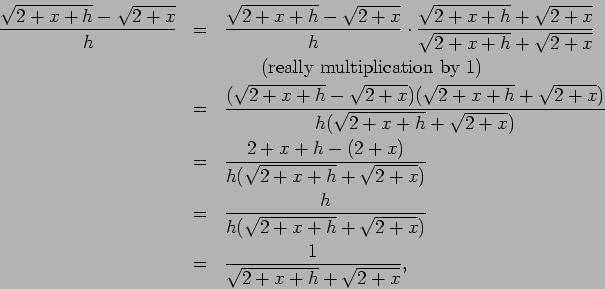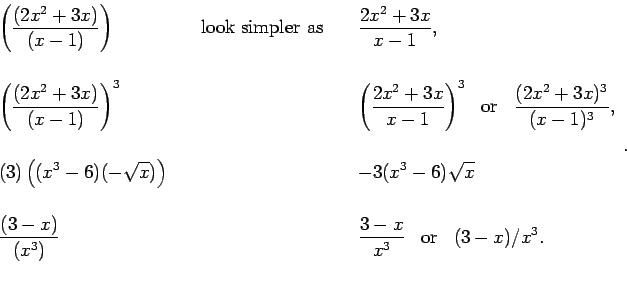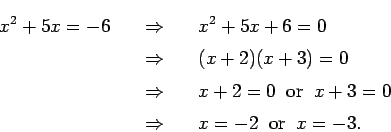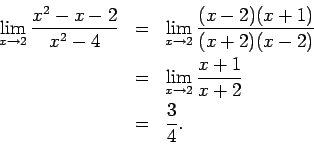by Thomas L. Scofield
Assistant Professor of Mathematics
Calvin College
In recent years, it has been observed that the average student enrolled in an introductory calculus course at the college level is not as adept as she once was in her prerequisite algebra/precalculus skills. Whether this comparison with the past is accurate or not, it is certainly true that the average student makes many errors of an algebraic (rather than a calculus) nature, and this serves only to divert her focus from the subject at hand.
To address the issue of poor algebraic skills, many writers of calculus texts now include a preliminary chapter for the review of precalculus concepts. While, in theory, such a review seems a good idea, in practice, the benefits, at least in the opinion of some, are dubious. In the ideal setting such a review would get ample time (with some students getting advised to take an entire precalculus course at the college level before entering calculus); instead, it is usually clear that the teacher is trying to spend the minimal time necessary so as to arrive at the calculus as early in the semester as possible.
This document was written, both out of experiences that have led to my abandoning an algebra review at the start of first semester calculus sections I teach, and out of certain realities at my institution. As to the former, it is my experience that a two-week review of precalculus is of little value. One might think that the stronger students might be bored for a couple of weeks while the struggling ones gratefully soak in the understanding of precalculus that has previously eluded them. In my experience, it works the other way around. The strong students -- the ones who would do relatively well with no review -- are the most engaged, while the weaker ones are buoyed up by a false confidence bred out of a sense of familiarity with the topics. For such students there are two rude awakenings to come at the end of the review: the score on the exam testing their knowledge of precalculus, and the very unfamiliar and difficult (to some more than others) concepts of calculus, now thrown more quickly at them because several weeks were given over to review. It is a discouraging way to begin a course, and many students never get their heads above water again during the semester. In addition to experiences such as these, I have a certain sympathy for the point of view that students who have enrolled in a calculus course should get just that, not some hybrid course that is inappropriate both for those who have strong algebra skills, and for those whose lack of algebraic facility calls for a more extensive study of precalculus.
As to the realities at my institution, recent changes have led to the addition, rather than elimination, of certain topics which had not formerly been in the first year of calculus. Roughly speaking, two and a half semesters have been compressed into two. Many of our students in first-year calculus are studying to be engineers, and these changes are the result of the attempts on the part of the Mathematics Department to accomodate the wishes of our Engineering Department, while maintaining a calculus sequence that is coherent and mathematically sound. As one might expect, we have tried to make the total course content for both semesters of calculus comparable to what it was before the change; we have increased breadth at the expense of depth. Nevertheless, several weeks of review at the start of a course seems a more remote possibility than before.
It is not my response to ignore the sometimes-incomplete backgrounds of our students, but to deal with the issue differently than with an initial precalculus review. I usually take a just-in-time approach, providing a short treatise on various precalculus concepts at the moments they become relevant in our discussion of calculus. For instance, I usually treat the subject of inverses about the time one discusses the chain rule, inverse trigonometric functions, or logarithms and exponentials. Still, the day-to-day algebraic errors which students make, such as the assumption that all functions behave linearly, are not directly addressed by a review of the most important precalculus concepts, whether this review comes all-at-once at the beginning of the course, or in short bursts interspersed among calculus topics. It is for these remaining pervasive errors that I have written this piece.
To be straight about it, its purpose is two-fold. One purpose is as mentioned above, to provide a detailed discussion of some of the most common algebraic errors. The other is to reduce the amount of writing a conscientious grader feels compelled to do. I achieve the latter by giving names and 3 or 4-letter acronyms to the error types. When one of these errors is seen, a grader need only write the acronym, not a long discussion of the error. The student who receives the abbreviated 4-letter comment is not shortchanged in the least. She may turn to this document, look up the acronym, read the accompanying discussion, and benefit from it just as much (more?) as she would have from a detailed comment.
Of course, for this grading/commenting system to be successful, students must have access to this document. It currently is available on the web at http://www.calvin.edu/~scofield/courses/materials/tae/.
Perhaps the bigger hurdle is that teachers must take the time to read and note which errors are addressed herein, along with the acronym used for each. It may take a nontrivial amount of time on the part of the instructor to get accustomed to all of these. Still, I believe the time invested in the beginning should, in the long run, reduce an instructor's grading time.
Please address comments on this document -- both those intended to improve discussion of errors already addressed and those indicating an error which you think should be addressed -- to the author. Also, if you use this document, a vote of confidence by way of a quick email would be appreciated.
Students can make a variety of mistakes when it comes
to working with exponents. Two of the most common are
Multiplying Exponents that should be Added (MEA),
and Adding Exponents that should be Multiplied (AEM).
This section does not deal with either of these, but rather
with a problem that some students have applying
two basic rules about exponents, the ones concerning
reciprocals and roots. Specifically, these are
The first of these says that
a factor of the denominator (see the discussion on
CES) raised to a power (be it positive or negative)
may be written as a factor to the oppositite power of
the numerator (i.e., a ![]() power becomes
power becomes ![]() , a
, a
![]() power becomes
power becomes ![]() ). The only change is to
the sign of the exponent. An example of a valid
application of this rule is
). The only change is to
the sign of the exponent. An example of a valid
application of this rule is
The second rule shows how to write a root as a power,
which can be especially helpful in calculus when a derivative
is desired. Things like
![\begin{displaymath}\begin{array}{lll}
\ds{\sqrt[3]{3x^2}} &
\mbox{may be writt...
... as} &
\ds{\frac{\sqrt{5}x^{1/2}}{(x-2)^{1/2}}}.
\end{array} \end{displaymath}](img29.png)

Another law of exponents frequently misunderstood by students is

Early on in one's high school algebra courses one learns several properties of equality -- namely
or, solve
Add 1 to both sides: Divide both sides by 3:
 :
:
Multiply both sides by the never-zero quantity :
Subtract 5 from both sides: Divide both sides by 4: .
In contrast, these are not, generally speaking, properties
one uses when trying to simplify an expression. (There
are exceptions to this, such as in the simplifying of
![]() and
and
![]() using integration by parts, but these are relatively rare.)
Students asked to find the derivative of
using integration by parts, but these are relatively rare.)
Students asked to find the derivative of



 .
.

The discussion here necessarily must begin with an appeal to the order of algebraic operations (OO). These are rules of hierarchy as to which operations to perform 1st, 2nd, etc. when an algebraic expression requires more than one operation be performed. There are three levels of hierarchy:

There really isn't an error, per se, with using
too many parentheses. Nevertheless, students who consistently
employ more parentheses than needed are demonstrating as much
of a lack of understanding of the order of algebraic operations
as those who use too few. Expressions such as

The properties of equality that were mentioned earlier are, by some
students, implemented incorrectly even when the situation calls for
their use. For instance, when solving an equation
like
Now let us return to the equation
Worse still is when a student thinks he can solve in one step
(that is, take care both of the multiplication by 3 and the addition
of 7 via one operation). Such a student may write something like
Much of one's mathematical experience prior to the calculus is spent
in solving equations. There are the kind of equations, known as
identities, where every number in the domain is a solution.
The equation
Another fact about conditional equalities is that comparatively few
of them may be solved exactly. Leaps in technology have made it
commonplace for students, with the purchase of a handheld calculator,
to have at their fingertips powerful graphing capability and numerical
methods for finding approximate solutions to many, perhaps even
most conditional equalities. This does not mean that one should
forego learning the algebraic techniques which lead to exact solutions,
thinking that deftness in pushing the right pair of buttons is an
appropriate substitute for the thinking processes such algebraic
methods introduce. Still, there is added value in the knowledge one
gets by investigating graphical methods. By these methods
one comes to think of the solutions of, say,


In summary, the error occurs in finding the zeros of a function and taking to be the roots of the equation, when the two concepts do not coincide. There is a simple way to make them coincide. We simply make one side zero (using a valid algebraic step, of course).

In precalculus/algebra we become familiar with the distributive
laws that address interactions between multiplication and
addition/subtraction. Specifically, these laws say

A prerequisite skill to writing good mathematics is the ability to write well in one's native tongue. People who cannot write a complete English sentence should take remediation in English composition before reading on.
What may surprise some students is that good writing using mathematical symbols (even in the write-up of homework problems) consists of using complete sentences, setting up one's ideas clearly and then following through on the details, much as one expects from a good English essay. The language and symbols of mathematics are used just like regular English words and phrases to express ideas, albeit ideas which one would often struggle to use any other means of expressing.
Nobody studies mathematical writing as a subject. Your mathematics professor(s) got to be good writers of mathematics, if good they be, by reading papers and books by other mathematicians, not by reading a treatise such as this one. If a book on good mathematical writing does exist (and there are probably a number of such books), they will say much more than I say here. I will only describe the most common example of poor mathematical writing I see when grading students' work: Using Equals as a Conjunction (UEC).
The word ``equals" has a very specific meaning. It requires two
objects, and it asserts that these two objects are the same. In
mathematics, the two objects are usually quantities, like the
mathematical expression ![]() , or the number 7. Even within
this tight definition, mathematical equations, as I mentioned earlier,
come in two varieties: identities and conditional equations.
A conditional equation is one such as the equation
, or the number 7. Even within
this tight definition, mathematical equations, as I mentioned earlier,
come in two varieties: identities and conditional equations.
A conditional equation is one such as the equation
Consider the typical calculus problem of evaluating a limit like


In contrast, suppose we begin with a (conditional) equation like
The student who writes (1) actually appears to have
some facility in the techniques for solving linear equations,
but lacks the ability to put her ideas onto paper in a meaningful
fashion. One good way to express the solution of the previous
equation is